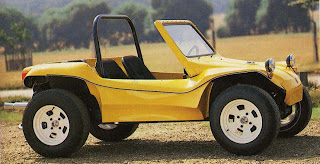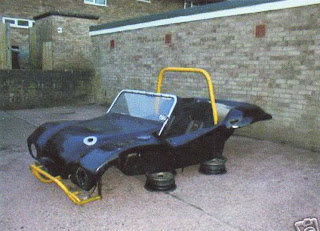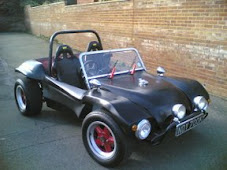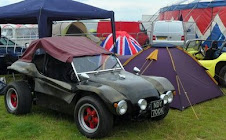 30th April 2011
30th April 2011Whilst I awaited my four coats of lacquer to go off hard I decided to get on with the fitting of the roll bar. This was to be moved as far back as it would go as my winged seats hit the old position when the seat was fully slide back. I therefore placed the roll bar right against the new 80mm body lift frame meaning that I could use a bolt through it for stability and eventually tie the two pieces of steel work together. The new position also did not sit
 on the fibre glass making it much stronger. The only problem with this position was that the rear hoop sat on the back neopolitan's hat so that the front bolt position hovered 20mm above the floor pan. I decided that I would need to make two pieces of steel to fit under here 20mm x 60mm x 55 mm. This would slip under the front tab and work better that washers to provide a solid base for the hoop. I placed the hoop in its position so that I could drill down through the chassis with an 11mm hole. I also drilled horizontally through the 80mm lift tubing so that I drilled its position to be able to drill right through the hoop. I repeated this for the other side and then removed the roll bar so that the body work could be left to dry. I would fit the 20mm x 60mm x 55mm blocks when the body was bolted back in place. Whilst the bodywork was still removed I used the 11mm drill to clearance the holes holding the body lift frame to the chassis. I checked each bolt would pass through without any restriction. I had sprayed the bonnet and side panels in black base coat when i sprayed the flake onto the body work . This did not require 2k Hardener so as I was running short and had used nearly all of my 1 litre of hardener up .
on the fibre glass making it much stronger. The only problem with this position was that the rear hoop sat on the back neopolitan's hat so that the front bolt position hovered 20mm above the floor pan. I decided that I would need to make two pieces of steel to fit under here 20mm x 60mm x 55 mm. This would slip under the front tab and work better that washers to provide a solid base for the hoop. I placed the hoop in its position so that I could drill down through the chassis with an 11mm hole. I also drilled horizontally through the 80mm lift tubing so that I drilled its position to be able to drill right through the hoop. I repeated this for the other side and then removed the roll bar so that the body work could be left to dry. I would fit the 20mm x 60mm x 55mm blocks when the body was bolted back in place. Whilst the bodywork was still removed I used the 11mm drill to clearance the holes holding the body lift frame to the chassis. I checked each bolt would pass through without any restriction. I had sprayed the bonnet and side panels in black base coat when i sprayed the flake onto the body work . This did not require 2k Hardener so as I was running short and had used nearly all of my 1 litre of hardener up . I decided that as I had to buy new hardener the with little I had I could spray the gold flake onto the bonnet, the dashboard and the side panels. It was quite difficult to match the same amount as I had put on the body work but hopefully have got a good match. The side pods came up surprising well but I managed to loose the station tube out of the end
I decided that as I had to buy new hardener the with little I had I could spray the gold flake onto the bonnet, the dashboard and the side panels. It was quite difficult to match the same amount as I had put on the body work but hopefully have got a good match. The side pods came up surprising well but I managed to loose the station tube out of the end  of the spray gun head and this put droplets of lacquer on the right hand pod. I guess even after spraying the whole body there are still things to learn about this gun. I have to wonder how much more there would be with a devilbliss or professional HLVP gun. I was however pretty pleased with the results of the Earlex PRO HV5000 spray station it had survived the spraying process and to be honest not done a to bad job. I still had 7 coats of 2k Acrylic lacquer to spray on all of the gold leaf components this left s
of the spray gun head and this put droplets of lacquer on the right hand pod. I guess even after spraying the whole body there are still things to learn about this gun. I have to wonder how much more there would be with a devilbliss or professional HLVP gun. I was however pretty pleased with the results of the Earlex PRO HV5000 spray station it had survived the spraying process and to be honest not done a to bad job. I still had 7 coats of 2k Acrylic lacquer to spray on all of the gold leaf components this left s ix on the bonnet,dash and side pods and four on the body work. The rest of the evening was devoted to moving some of my car parts to my new garage I had found. This hopefully would be a new base for the buggy and would provide a new site to reassemble all the components. I had one dead line in my mind this year BUG JAM I hoped I would have the car back together with an MOT this was only two months away and although it had took a day to disassemble the parts I new it would take much longer to assemble the parts despite the time needed to put the rest of the lacquer on the parts.
ix on the bonnet,dash and side pods and four on the body work. The rest of the evening was devoted to moving some of my car parts to my new garage I had found. This hopefully would be a new base for the buggy and would provide a new site to reassemble all the components. I had one dead line in my mind this year BUG JAM I hoped I would have the car back together with an MOT this was only two months away and although it had took a day to disassemble the parts I new it would take much longer to assemble the parts despite the time needed to put the rest of the lacquer on the parts.Paint costs for the paint, lacquer, flake, primer costs was mounting up and currently was at £379.00 just for the supplies, this was quite astonishing. I would discuss this in a later article when the painting was completely finished.










































